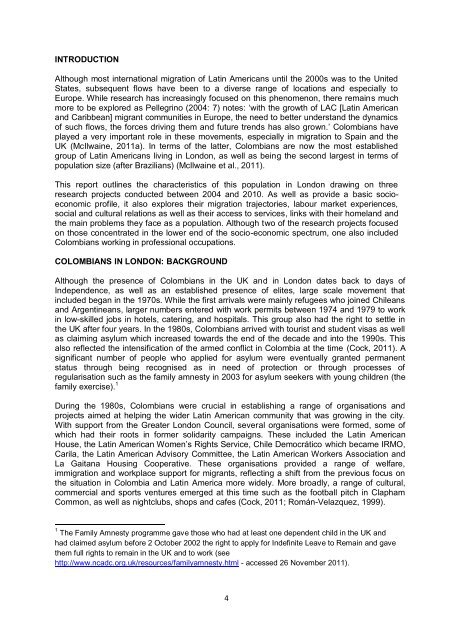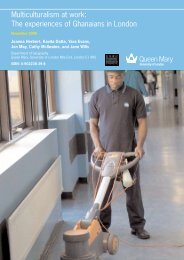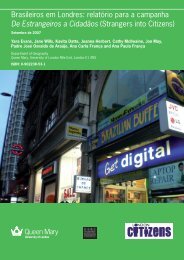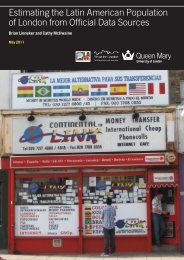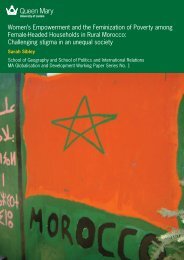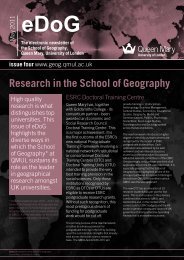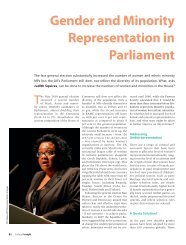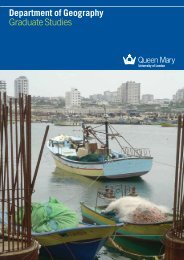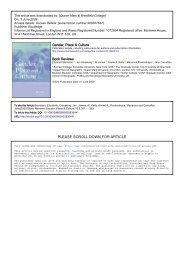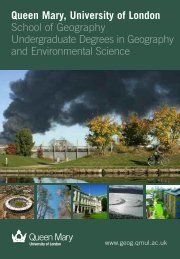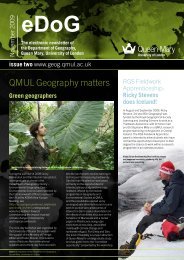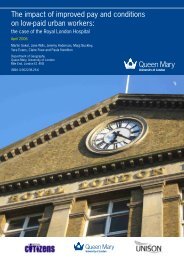The Colombian community in London - Geography - Queen Mary ...
The Colombian community in London - Geography - Queen Mary ...
The Colombian community in London - Geography - Queen Mary ...
- No tags were found...
You also want an ePaper? Increase the reach of your titles
YUMPU automatically turns print PDFs into web optimized ePapers that Google loves.
INTRODUCTION<br />
Although most <strong>in</strong>ternational migration of Lat<strong>in</strong> Americans until the 2000s was to the United<br />
States, subsequent flows have been to a diverse range of locations and especially to<br />
Europe. While research has <strong>in</strong>creas<strong>in</strong>gly focused on this phenomenon, there rema<strong>in</strong>s much<br />
more to be explored as Pellegr<strong>in</strong>o (2004: 7) notes: „with the growth of LAC [Lat<strong>in</strong> American<br />
and Caribbean] migrant communities <strong>in</strong> Europe, the need to better understand the dynamics<br />
of such flows, the forces driv<strong>in</strong>g them and future trends has also grown.‟ <strong>Colombian</strong>s have<br />
played a very important role <strong>in</strong> these movements, especially <strong>in</strong> migration to Spa<strong>in</strong> and the<br />
UK (McIlwa<strong>in</strong>e, 2011a). In terms of the latter, <strong>Colombian</strong>s are now the most established<br />
group of Lat<strong>in</strong> Americans liv<strong>in</strong>g <strong>in</strong> <strong>London</strong>, as well as be<strong>in</strong>g the second largest <strong>in</strong> terms of<br />
population size (after Brazilians) (McIlwa<strong>in</strong>e et al., 2011).<br />
This report outl<strong>in</strong>es the characteristics of this population <strong>in</strong> <strong>London</strong> draw<strong>in</strong>g on three<br />
research projects conducted between 2004 and 2010. As well as provide a basic socioeconomic<br />
profile, it also explores their migration trajectories, labour market experiences,<br />
social and cultural relations as well as their access to services, l<strong>in</strong>ks with their homeland and<br />
the ma<strong>in</strong> problems they face as a population. Although two of the research projects focused<br />
on those concentrated <strong>in</strong> the lower end of the socio-economic spectrum, one also <strong>in</strong>cluded<br />
<strong>Colombian</strong>s work<strong>in</strong>g <strong>in</strong> professional occupations.<br />
COLOMBIANS IN LONDON: BACKGROUND<br />
Although the presence of <strong>Colombian</strong>s <strong>in</strong> the UK and <strong>in</strong> <strong>London</strong> dates back to days of<br />
Independence, as well as an established presence of elites, large scale movement that<br />
<strong>in</strong>cluded began <strong>in</strong> the 1970s. While the first arrivals were ma<strong>in</strong>ly refugees who jo<strong>in</strong>ed Chileans<br />
and Argent<strong>in</strong>eans, larger numbers entered with work permits between 1974 and 1979 to work<br />
<strong>in</strong> low-skilled jobs <strong>in</strong> hotels, cater<strong>in</strong>g, and hospitals. This group also had the right to settle <strong>in</strong><br />
the UK after four years. In the 1980s, <strong>Colombian</strong>s arrived with tourist and student visas as well<br />
as claim<strong>in</strong>g asylum which <strong>in</strong>creased towards the end of the decade and <strong>in</strong>to the 1990s. This<br />
also reflected the <strong>in</strong>tensification of the armed conflict <strong>in</strong> Colombia at the time (Cock, 2011). A<br />
significant number of people who applied for asylum were eventually granted permanent<br />
status through be<strong>in</strong>g recognised as <strong>in</strong> need of protection or through processes of<br />
regularisation such as the family amnesty <strong>in</strong> 2003 for asylum seekers with young children (the<br />
family exercise). 1<br />
Dur<strong>in</strong>g the 1980s, <strong>Colombian</strong>s were crucial <strong>in</strong> establish<strong>in</strong>g a range of organisations and<br />
projects aimed at help<strong>in</strong>g the wider Lat<strong>in</strong> American <strong>community</strong> that was grow<strong>in</strong>g <strong>in</strong> the city.<br />
With support from the Greater <strong>London</strong> Council, several organisations were formed, some of<br />
which had their roots <strong>in</strong> former solidarity campaigns. <strong>The</strong>se <strong>in</strong>cluded the Lat<strong>in</strong> American<br />
House, the Lat<strong>in</strong> American Women‟s Rights Service, Chile Democrático which became IRMO,<br />
Carila, the Lat<strong>in</strong> American Advisory Committee, the Lat<strong>in</strong> American Workers Association and<br />
La Gaitana Hous<strong>in</strong>g Cooperative. <strong>The</strong>se organisations provided a range of welfare,<br />
immigration and workplace support for migrants, reflect<strong>in</strong>g a shift from the previous focus on<br />
the situation <strong>in</strong> Colombia and Lat<strong>in</strong> America more widely. More broadly, a range of cultural,<br />
commercial and sports ventures emerged at this time such as the football pitch <strong>in</strong> Clapham<br />
Common, as well as nightclubs, shops and cafes (Cock, 2011; Román-Velazquez, 1999).<br />
1 <strong>The</strong> Family Amnesty programme gave those who had at least one dependent child <strong>in</strong> the UK and<br />
had claimed asylum before 2 October 2002 the right to apply for Indef<strong>in</strong>ite Leave to Rema<strong>in</strong> and gave<br />
them full rights to rema<strong>in</strong> <strong>in</strong> the UK and to work (see<br />
http://www.ncadc.org.uk/resources/familyamnesty.html - accessed 26 November 2011).<br />
4


